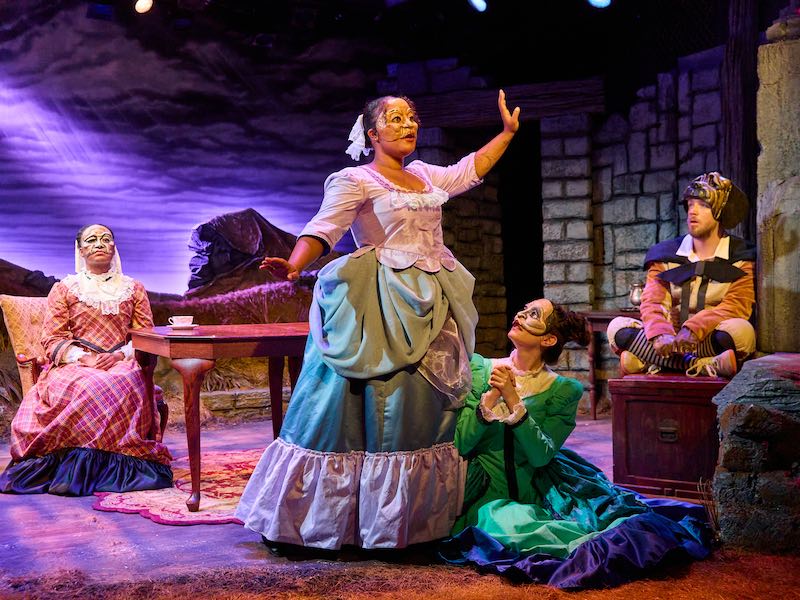“Playwrights … want to hide ourselves, and we want to expose ourselves at the same time,” Jen Silverman said in an interview with American Theatre. In their dark comedy The Moors — just opened at Faction of Fools — “the characters make inexorable mistakes because they are so close to finally breaking out of their loneliness, they take one final step and go over the edge of the cliff.”
Faction of Fools practices the Renaissance-era form of commedia dell’arte. The company’s philosophy also encompasses the notion of paradox: They infuse the tradition of masked physical comedy with contemporary ideas, making it fearfully and wonderfully accessible to a modern audience.
The Moors, inspired by the Brontës, is like that too; it is demonstrably designed to be happening right here, right now.

As in Charlotte Brontë’s Jane Eyre, the governess Emilie (Jasmine Proctor) arrives at a house in the middle of the mysterious moors. Unlike the reticent and morally exacting Jane, Emilie is giddy and eager to please. She is intrigued by letters she has received from a “Master Branwell” and looks forward to meeting him and assuming her position. Proctor’s performance as Jasmine is full of lightning changes of mood and exceptionally perceptive. Her character is one audiences can identify with amid the madness all around. Her rendition of “Emilie’s Song” is tender and moving.
Her prospective employers are sisters, like the Brontës. The older one, Agatha (Arika Thames), is high-handed and fond of domination. The younger one, Huldey (Natalie Cutcher), is something of a romantic and appears slightly insane. The physicality of their characters is always surprising, sometimes entertaining, sometimes terrifying. The Brontës’ obsession with creativity is evoked by Huldey’s diary and her dream of being a famous writer. But Agatha and Huldey specialize in mutual aggression — in that sense they are like Solange and Claire in Jean Genet’s The Maids. Thames’ Agatha has a stern posture and many secrets, which she reveals slowly and with excruciating precision. Cutcher’s Huldey is an astonishingly capricious creature, whose performance builds to a shocking, seemingly inevitable conclusion.
The dialogue is full of dark humor. Here is Huldey, on the subject of, what else, the moors:
I just know you’ll love it here! The bracing air, and the strange, thorny flowers, and the gorse…and there are lots of long walks you might take. Although there’s quicksand of course, and also large ravenous birds, and if you walked too far you might get turned around, and lost and starve to death, or you might be eaten by something. But in general, the moors are very pretty.
There is a servant, played by Rebecca Ballinger. At first glance she is wearing sunglasses, leaning against a door jamb with an air of voluptuous defeat. She is called Marjory, but is actually two maids, Marjory and Mallory, one of whom has typhus (a scourge in the Brontës’ time) and the other of whom is pregnant. Marjory encapsulates the dialogue between Self and Other that permeates the structure of the play. Even the setting, which is always the same, is said to be at times the parlor, Emilie’s bedroom, even the scullery. As in Macbeth’s “dagger” soliloquy, “nothing is but what is not.”

In a parallel storyline, the Mastiff (Ricky Drummond) and the Moor-hen (Mary Myers) enter into a fragile relationship. Drummond’s Mastiff is a whimsical seeker of meaning, while Myers as the Moor-hen attempts to keep him in touch with their strange lived reality. At times their exchanges have a Waiting for Godot–like quality. Like Beckett’s Godot, commedia is meant to be performed by clowns.
The moors, pictured behind the main setting, are also a major character. In a letter, Charlotte Brontë notes that a local newspaper described her home thus: “situated amongst the bogs and Mountains and until very lately supposed to be in a state of semi-barbarism.” Charlotte herself states, in another letter, that “we live a long way from towns and people hardly wish to take the trouble of crossing the mountains which form a barrier round us.” They too both hide and reveal. Emily, Charlotte said, was at her happiest there.
Director Francesca Chilcote’s production is one in which movement is uniquely fascinating and central to character. Scenic Designer Johnny Weissgerber’s conception strikes a perfect balance between period and modern themes. The elegant parlor, or bedroom, or scullery, features a stone fireplace and a rug that plays a critical role in the plot. Costume Designer Alison Samantha Johnson’s work is appropriately eclectic; the sisters’ costumes have a somewhat period feeling, while the Mastiff’s and the Moor-hen’s are comically timeless.
Music and sound are beautifully suited to every mood — sound design and music arrangement are by Kenny Neal. Music director and Commedia coach is Kathryn Zoerb. The evocative lighting is by Lighting Designer William K. D’Eugenio.
Props design by Amy Kellett and mask design by Tara Cariaso add to the touch of fantasy that brings the play very much into the present.
There are some slow moments at first, but they disappear relatively quickly.
At the heart of The Moors, according to Silverman, is a mystery. In that sense, you may get to know the characters. You may not. In any case you are in for a spectacularly original theater experience.
Running Time: Two hours and 10 minutes, including one 10-minute intermission.
The Moors plays through August 10, 2024, presented by Faction of Fools Theatre Company performing in the black box theater inside the Capitol Hill Arts Workshop at 545 7th Street SE, Washington, DC. Tickets are on a sliding scale ($25, market rate; $35, “pay it forward”; $15, lower income/child) and can be purchased at the door and online.
The program for The Moors is online here.
Recommended for ages 13 and up. Contains adult content, violence, loud noises, and strobe lighting.
COVID Safety: Medical-mask-required performances are on Saturday, July 27, at 2 pm; Saturday, August 3, at 2 pm; and Saturday, August 10 at 2 pm Masks will be available at the box office. For all other performances, masks are not required.
The Moors
Written by Jen Silverman
Directed by Francesca Chilcote
CAST OF CHARACTERS
Agatha: Arika Thames
Huldey: Natalie Cutcher
Emilie: Jasmine Proctor
Marjory: Rebecca Ballinger
The Mastiff: Ricky Drummond
A Moor-hen: Mary Myers
Understudies: Natalia Fyfe, Aja Goode, and Seth Langer
PRODUCTION TEAM
Stage Manager: Samantha Nodarse Owen
Assistant Director: Deimoni Brewington
Scenic Designer: Johnny Weissgerber
Mask Designer: Tara Cariaso of Waxing Moon Masks
Costume Designer: Alison Samantha Johnson
Lighting Designer: William K. D’Eugenio
Sound Design & Music Arrangment: Kenny Neal
Music Director & Commedia Coach: Kathryn Zoerb
Props Designer: Amy Kellett
Intimacy & Fight Choreographer: Megan Behm



